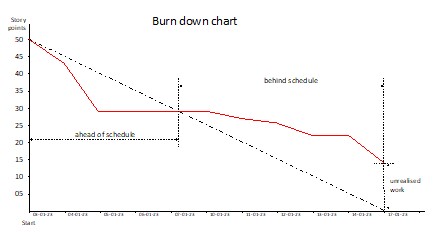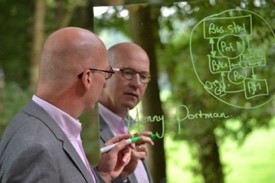Sensemaking in the Agile Forest
SERIES ARTICLE
By Henny Portman
The Netherlands
Introduction
Agile and management products may seem like a contradiction in terms, but nothing could be further from the truth. Even within an agile approach, some simple management products can ensure better manageability of the work. In this blog, the burn down chart, the burn up chart and the cumulative flow diagram will be highlighted successively.
The burn down chart
When using Scrum, the burn down chart is a simple tool, used and maintained by the agile team to show the status of the sprint. With a simple glance at the chart, it becomes clear if the team is behind, on, or ahead of schedule within the sprint.
The red line shows how many story points the team still needs to realize. At the end of sprint day 1, 8 story points have been realized and the team still needs to realize 42. At the end of the sprint, 35 of the 50 story points have been realized. So, 15 story points have not been realized. If the team is below the dotted line, then the team is ahead of schedule and if the team is above the dotted line, then the team is behind schedule. At the end of day 5, the team can therefore already identify that they are behind schedule.

If during the retrospective it is found that there is no explainable reason for the achievement of only 35 story points, the team can decide to change the velocity to 35 story points.
The burn up chart
The burn up chart is more complex than the burn down chart. It shows the total project scope in addition to the work completed. On the horizontal axis are the sprints (or days or weeks) within a project. On the vertical axis are story points. At the start of the project, it was determined that there is a backlog of user stories with a size of 400 story points (the blue line). The estimate is to achieve that in 7 sprints (end date 1).
More…
To read entire article, click here
Editor’s note: This is the 10th article in a series by Henny Portman, one of the world’s leading authorities on “agile”. Based in The Netherlands, Henny coined the term “agile forest” in 2019 to describe the many agile frameworks that have emerged over the last 20 years. This series is intended to help readers better understand the agile concept, navigate through the ‘underbrush’ and more successfully apply whichever framework is selected for their projects.
How to cite this article: Portman, H. (2023). Agile management products, Sensemaking in the Agile Forest series article, PM World Journal, Vol. VII, Issue II, February. Available online at https://pmworldlibrary.net/wp-content/uploads/2023/02/pmwj126-Feb2023-Portman-14-agile-management-products.pdf
About the Author

Henny Portman
The Netherlands
![]()
Henny Portman, owner of Portman PM[O] Consultancy and was partner of HWP Consulting, has 40 years of experience in the project management domain. He was the project management office (PMO) thought leader within NN Group and responsible for the introduction and application of the PMO methodologies (portfolio, program, and project management) across Europe and Asia. He trains, coaches, and directs (senior) programme, project and portfolio managers and project sponsors at all levels, and has built several professional (PM(O)) communities.
Henny Portman is accredited in a variety of qualifications, including P3O, PRINCE2, MSP, MoP, PRINCE2 Agile, AgilePM, AgilePgM and AgileSHIFT trainer and an SPC4 SAFe consultant and trainer. He is a P3M3 trainer and assessor and PMO Value Ring Certified Consultant (PMO Global Alliance). On behalf of IPMA, he assesses mega and large projects for the IPMA Project Excellence Award. In addition to this, he is an international speaker, author of many articles and books in the PM(O) field, and an active blogger. More at hennyportman.wordpress.com
Henny can be contacted at henny.portman@gmail.com
To view other works by Henny Portman, visit his author showcase in the PM World Library at https://pmworldlibrary.net/authors/henny-portman/









